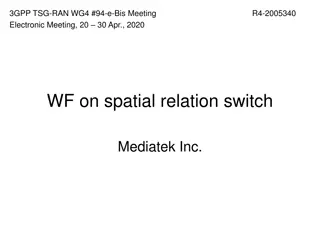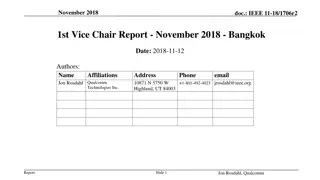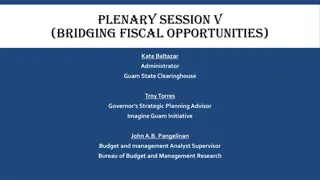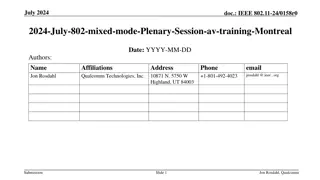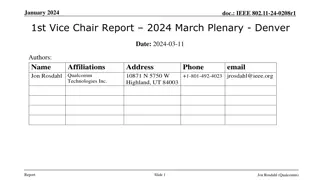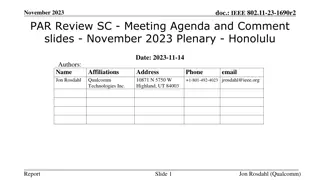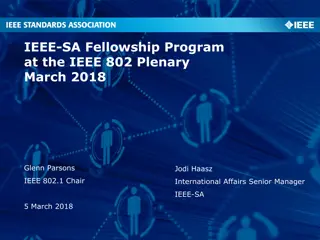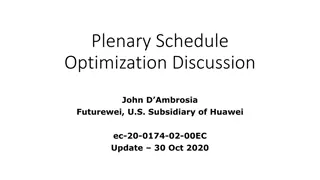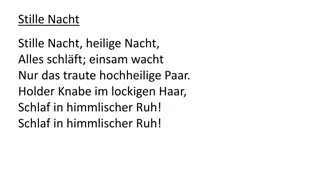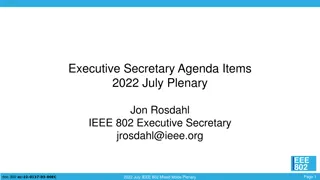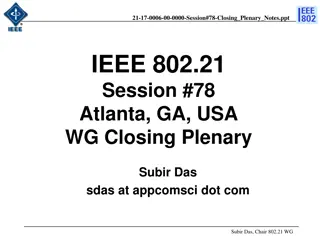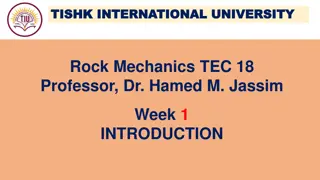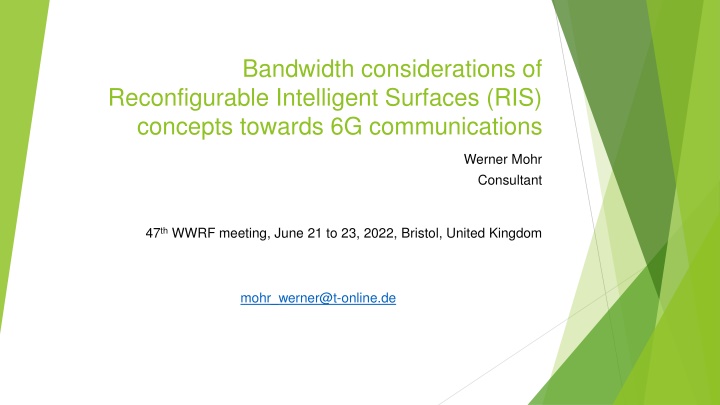
Bandwidth Considerations of Reconfigurable Intelligent Surfaces for 6G Communications
Learn about the bandwidth considerations of Reconfigurable Intelligent Surfaces (RIS) in the context of 6G communications, exploring the objectives of RIS systems, multipath propagation channels, ideal system conditions, channel capacity estimates, and strategies to enhance radio channel bandwidth.
Download Presentation

Please find below an Image/Link to download the presentation.
The content on the website is provided AS IS for your information and personal use only. It may not be sold, licensed, or shared on other websites without obtaining consent from the author. If you encounter any issues during the download, it is possible that the publisher has removed the file from their server.
You are allowed to download the files provided on this website for personal or commercial use, subject to the condition that they are used lawfully. All files are the property of their respective owners.
The content on the website is provided AS IS for your information and personal use only. It may not be sold, licensed, or shared on other websites without obtaining consent from the author.
E N D
Presentation Transcript
Bandwidth considerations of Reconfigurable Intelligent Surfaces (RIS) concepts towards 6G communications Werner Mohr Consultant 47thWWRF meeting, June 21 to 23, 2022, Bristol, United Kingdom mohr_werner@t-online.de
Outline Introduction and objectives of RIS systems Multipath propagation channel System- and signal-theoretical conditions for an ideal frequency-independent RIS system Delays and phase shifts in realistic multipath propagation channels Optimum RIS settings Estimated channel capacity Impact of displacements of the mobile station Approach to increase achievable bandwidth of radio channel transfer function Conceptual implementation and operational aspects Conclusion 2
Introduction and objectives of RIS systems In 5G and 6G systems frequency bands above 20 GHz and in 6G up to the sub- Terahertz domain are considered Such systems are using wide carrier bandwidth in the order of several hundred MHz to several GHz Radio channel has significant impact on system performance and is characterized by distant dependent pathloss multipath propagation shadowing atmospheric, rain and foliage attenuation which results in a statistical description of the channel New concepts like Reconfigurable Intelligent Surfaces (RIS) intends to influence the radio channel environment that at the receiver the different multipath components are super imposed constructively and thereby the channel capacity is increased compared to standard SISO transmission Main objective of this paper: Which bandwidth can be achieved by RIS systems? 3
Basic RIS approach f11 f12 f13 f1N f2N f22 f21 f23 RIS array f31 f32 f33 f3N ly ??,? fM1 fMN fM2 fM3 Transmitter lx ??,? Receiver ? Standard SISO: reflected waves at surfaces >> wavelength are plane waves 1 ??????????? ? ???+ ??? In RIS systems scattering at small RIS elements < wavelength result scattered spherical waves (bistatic Radar equation) 1 ??????????? ? ??? ??? Multipath propagation channel ? ??? = ? ?(?) + ?,? ? ? ?? ?=1 ??= ???,?+ ???,? 4
Basic RIS approach Received power and channel capacity Standard SISO transmission, summing up power contributions of different paths ? 2 2+ ??,????= ?? ???,? ??( , ) ? ?,? ?=1 2 ? 2+ ?=1 ?? ??( , ) ??( , ) ? ?,? ?????= ????? log2 1 +??,???? =????? log2 1 + ? ? RIS transmission, summing up amplitude contributions of different paths 2 ? ??,???= ?? ?? ?? ??+ ?,? ?=1 2 ? ??+ ?=1 ????= ???? log2 1 +??,??? =???? log2 1 +?? ??( , ) ??( , ) ?,? ? ? Inequality holds 2 ? ? 2 2+ ?? ?,? ??+ ?,? ?=1 ?=1 5
Multipath propagation channel Path difference dmax or delay difference max with 3 dB beamwidth ??? of base station and ??? of mobile station antenna normalized to the distance d y MS: omni antenna for mobility directive or adaptive antenna for fixed wireless access BS: directive or adaptive antenna r1 r2 BS MS 2 b BS MS x d = 2 c 2 a For ???< 360 ??? tan??? tan??? ???? ? = ???? ?0 2 2 = + 1 cos??? tan??? + tan??? cos??? tan??? + tan??? ? 2 2 2 2 2 2 For ??? 360 ??? theoretically ????/? and ????/? 6
Multipath propagation channel Maximum path length or delay difference ???? ? or ???? For MS 360 - BS: ???? ? ???? ? ? [ s/m] [m/m] 180 150 120 100 80 60 3 1000 40 BS [ ] Parameter 20 1 s/m 10 2 100 0.1 s/m 10 1 0.01 s/m 0 1 1 1 ns/m -1 0.1 0.1 ns/m -2 0.01 0.01 ns/m -3 0.001 1 ps -4 0.0001 0.1 ps -5 0.00001 1 50 100 150 200 250 300 350 MS [ ] In practical situations especially in bigger halls and outdoor scenarios long delays in the order of 1 s corresponding to 300 m in free space possible 7
System- and signal-theoretical conditions for an ideal frequency-independent RIS system Frequency independent radio channel transfer function requires single path model ????? = ??? ? ?? ?max ?? ???? = ??? ?(? ?max) Possible, if all resolvable paths are delayed to maximum path delay ???? ? ? ??,???? = ? ?(? ????) + ?,? ? ? ?? ?? = ??+ ?,? ? ? ???? = ??? ? ? ???? ?=1 ?=1 Delay equalization for Rayleigh channels All paths are affected by reflection and could be influenced by RIS elements Single path impulse response theoretically feasible Delay equalization for Rice channels Except direct path all paths are affected by reflection and could be influenced by RIS elements Two-path impulse response theoretically feasible, which is frequency dependent In practice not feasible due to very long required delay lines (several m to several 100 m) gd(t) = ? ? ? ? ? ???? gr,1(t) = ?,1 ? ? ?1 + s(t) r(t) ? ? ( ???? ?1) gr,I(t) = ?,? ? ? ?? ? ? ( ???? ??) 8
Delays and phase shifts in realistic multipath propagation channels Path d and delay differences are transformed in phase differences ? with respect to first path at given carrier frequency f ? = 2 ? ? = 2 ? ? ? = 2 ? ? ? ? = ?0 ? ? ?0 Practical path delays are transformed in huge phase shifts log( [rad]) 10 8 10 7 1000 GHz 300 GHz 10 6 100 GHz 30 GHz 10 5 10 GHz 3 GHz 10 4 1 GHz 1000 100 10 1 1 s 1 ns 10 ns 100 ns 9 log( )
Optimum RIS settings Radio channel transfer function Hmp( ) around 0 is Fourier transform of multipath channel impulse response hmp (t) ? ? ??? ? ????? = ? ????? = ?+ ?,? ? ???? ???? = ? ? ? + ?,? ? ? ?? ?=1 ?=1 Maximum of received amplitude requires that all multipath components show the same phase at carrier frequency 0 ? ? Re ????0 = ?+ ?,? cos ?0?? = ??? Im ????0 = ?,? sin ?0?? = 0 ?=1 ?=1 This is fulfilled for adjusted tap delays i and phase shifts ?0?? = 2? ? for i= 1, 2, 3 I ?? = 2 ? ?? = 2 ? ?0 ?? = 2? ? ? Tap delays of RIS affected impulse response hmp (t) are adjusted to the raster ? ?0 ?0 ? ? ? or reduced resolution for Bsystem ?? = ???? = ???? = ?? = ??????? ??????? ? = Int ? ??????? 10 ?0
Optimum RIS settings Channel transfer function Channel transfer function H mp( ) for optimal RIS settings of impulse response hmp (t) ? ? ? 1 ?0 ?? ? = ??? ?= ? ? ? 1 ??? ? = ??? = ??? ? ? ? 0 ?0 ?= ?= 1?0 ?? ? = ???? ? Envelope of the channel impulse response (?) . ? ???? ? 11
Optimum RIS settings Examples Triangular impulse response Exponential impulse response Rectangular impulse response ? ? 1 0 ? ???? ? ? ? ? ? 0 ? ???? t 0 ???? ??? = ??? = ??? = 0 ? < 0 and ? > ???? 0 ? < 0 0 ? < 0 ??? ? > ???? ? = ln0.01 sin ? ???? sin ? ???? ? ? ? ???? ? = ? ? ? ? ???? ???? 2 2 3 ??? ? = ? 2 ??? + 2 2 ? ? ? ?? ?2+ ?2 cos ? ???? sin ? ???? ??? ? = ? ? ? ? 2???????? 2 2 +? ? ? ? ? 0 ?= ???? 2 ? ?2 ?= max = 1 s max = 1 s max = 1 s ?3 dB= ???????,???= 1460 kHz 1 ???? ?3 dB= ???????,???= 900 kHz 1 ???? ?3 dB= ???????,???= 880 kHz 1 ???? 1 1 1 = 1 ??= 1 MHz = 1 ??= 1 MHz = 1 ??= 1 MHz 12
Estimated channel capacity, SISO versus RIS With slide 5 the ratio of receive power and channel capacity is given as 2 2 ? ? ?+ ?=1 ?2+ ?=1 ?+ ?=1 ?2+ ?=1 ??,???,?????????? ??,????,???????? ?? ??( , ) ??( , ) ?,? ?,? = 2= 2 ? ? ?? ??( , ) ??( , ) ?,? ?,? Assumption: all paths have the same amplitude with I resolvable paths plus a direct path ? = ?,? = ? and ? = ? + 1 Results in power ratio, which increases with L of I, respectively 2 2 ? ??+ ?=1 2+ ?=1 ??,???,?????????? ??,????,???????? ?,? ? = 2= 2= ? = 10 log? ? ?? ?,? ? It can be shown that the following bandwidth relation holds ? = ??????? ????= ???????,???? ???? Results in ratio of channel capacity (Bsystem,SISO >> coherence bandwidth, fading process is ergodic) 2 ? ???????,???? log2 1 +?? ??( , ) ??( , ) ?0 ???????,???? ?????,???????? ????,?????????? =? log21 + ??? ? log21 + ??? ?3 = 2 ?3 ???????,???? ? log2 1 +?? ??( , ) ??( , ) ?0 ???????,???? 13
Estimated channel capacity, SISO versus RIS Channel capacity CRIS,narrowband is smaller than CSISO,wideband Normalized RIS transfer function for optimal RIS settings compared to average transfer function for parameters: f0 = 10 GHz, Bsystem = 100 MHz, I = 99, 100, 101, max = 1 s Gain of CSISO,wideband compared to CRIS,narrowband is increasing with SNR and number L of resolvable paths The reduced RIS bandwidth Bsystem RIS = Bsystem,SISO/L is reducing the channel capacity CRIS,narrowband linearly in front of the logarithm and is increasing CRIS,narrowband logarithmically, which results in an overall reduction compared to CSISO,wideband 14
Impact of displacements of the mobile station Propagation scenario, example Path lengths Reflector ?2+ ?1 ?2 ?0= ?2+ ?1+ ?2 ?1= ?2+ 2 ?2 ?1 ?2 ?2= Reflector Delays in impulse response Associated path lengths and receiver coordinates at optimal RIS settings ?0= 0 s ?1= 0.5 s ?2= 1.0 s ?0= 1000 m ?1= 1150 m ?2= 1300 m ?1= 283.9454 m ?2= 699.2765 m ? = 2 ? ? = 2 ? ? Phase differences at 10 GHz ? = 2 ? ? ? ? ?0 ?1= 2 ? ?1 ? = 2 ? 5000 ?2= 2 ? ?2 ? = 2 ? 10000 15
Impact of displacements of the mobile station ? = ?? ? ? ?1+ ? ? ?2+ ? ? ?3 ??= 2? ? ? 2 2+ sin ?1+ sin ?2+ sin ?3 ? = ?? cos ?1+ cos ?2+ cos ?3 Displacement along x-axis Displacement along y-axis Displacement by 0.36 m or 12 (upper figure) and by 3.6 m or 120 (lower figure) 16
Approach to increase achievable bandwidth of radio channel transfer function Approach 5G and 6G systems require system bandwidth in the order of several hundred up to several GHz Bandwidth increase by a RIS array, where different RIS array elements are optimized for different center frequencies With 1 ??????? (? 1) ???????,??? ? ???????,???= ? ?3 dB for L >> 1 ?3 dB= ???????,??? ???? ??????? ???????,??? ??????? ?3 dB ? = Int + 1 = Int + 1 = Int ??????? ???? + 1 RIS elements per array or different transfer functions are required 17
Approach to increase achievable bandwidth of radio channel transfer function Approach Optimization of different sets for different center frequencies by appropriate tap spacing 1 ?0,?= ?0+ ? 2 ?3 ?? ? 2 ? ? ??+Int?0+? ?3 ?? ??????? ??= ??= ?system 2 Around the carrier frequency 0 the broadband transfer function ??? ?/2 ? follows ??? ? = ??? ? ? 0 ? 2 ?3 ?? ?/2 ? is described by the sum of frequency shifted Fourier transforms of the impulse response ??? ??? = ???(?) ?/2 ??? ? = ???(? 0 ? 2 ?3 ??) ?/2 2 2 ?/2 ?/2 ??? ? = Re ???? 0 ? 2 ?3 ?? + Im ???? 0 ? 2 ?3 ?? ?/2 ?/2 18
Approach to increase achievable bandwidth of radio channel transfer function Examples Rectangular impulse response Exponential impulse response ??? ? ?/2 ?/2 ? 0 ? 2 ?3 ?? ???? ? ? 0 ? 2 ?3 ?? ?2+ ? 0 ? 2 ?3 ?? sin ?/2 ??? = ?? 2 ? ?? 2 ? 0 ? 2 ?3 ?? ???? ?2+ ? 0 ? 2 ?3 ?? 2 = ?? 2 cos ?/2 ?/2 ? 0 ? 2 ?3 ?? 2 ?/2 ? 0 ? 2 ?3 ?? ???? sin ?/2 2 ? 0 ? 2 ?3 ?? ???? ? ?? 2 sin ? 0 ? 2 ?3 ?? 2 ?/2 max = 1 s, Parameters: Bsystem = 10 MHz, Bsystem,RIS 1 MHz, L at least 10 19
Approach to increase achievable bandwidth of radio channel transfer function Channel capacity Standard SISO and RIS have the same bandwidth Bsystem,SISO = Bsystem,RIS Optimistic assumption: the received path amplitudes for SISO and RIS are the same All resolvable paths have the same amplitude h (rectangular envelope of impulse response) ?????,????????= ???????,???? log2 1 +?? ??( , ) ??( , ) ? 2 ?0 ???????,???? 2 ????,????????= ???????,??? log2 1 +?? ??( , ) ??( , ) ? ?0 ???????,??? Ratio of channel capacity with SNR ??? =?? ??( , ) ??( , ) 2 ?0 ???????,???? ?????,???????? ????,???????? =log21 + ??? ? log21 + ??? ?2 20
Approach to increase achievable bandwidth of radio channel transfer function Channel capacity Gain in channel capacity of RIS compared to SISO system is rather limited: 0.5 ?????,???????? ????,???????? 1 Gain disappears, when scattering (spherical waves) at RIS elements considered compared to reflection at bigger areas (plane waves) in standard SISO case Limiting values For L = 1 both systems provide same channel capacity ?????,???????? ????,???????? ? and ???=1 log21 + ??? ? log21 + ??? ?2= log2? = lim = 0.5 log2? + log2? ????=,???????? ????,???????? log21 + ??? ? log21 + ??? ?2= log2??? +log2? log2??? + log2? + log2? = lim ??? = 1 21
Implementation and operational aspects Conceptual implementation aspects At receiver channel estimation necessary for all significant resolvable paths Channel estimation sent to different RIS arrays and/or for centralized calculation of optimal RIS settings to base station Most probably, centralized calculation of RIS settings required for simultaneous adjustment of all RIS elements and different center frequencies for sub-transfer functions to support requested system bandwidth Settings communicated from base station to all RIS arrays either via an additional radio link or fixed lines Fast adaptation of RIS setting in case of mobility Different users at different locations require different RIS elements Therefore, RIS array size depends on system bandwidth, length of channel impulse response and number of simultaneous users Different RIS arrays need to be deployed in radio environment, where main reflection areas occur, e.g., at buildings Due to limited physical RIS size not feasible that each RIS element can adjust path delay especially for longer impulse responses, only phase shift of each path can be adjusted Wideband systems like 5G or 6G require huge number of sub- transfer functions Operational aspects RIS system requires deployment of additional equipment on top of base station sites RIS arrays including centralized evaluation of channel estimation calculation of optimal RIS settings and signaling of RIS settings to RIS arrays Such additional equipment requires site acquisition for RIS arrays in addition to often difficult site acquisition of base station antenna sites power supply for RIS arrays for controlling electronics potentially fixed lines from central RIS optimization in base station to different RIS arrays negotiations and agreements with building owners to deploy and operate RIS arrays additional maintenance of RIS arrays on top of other networking elements 22
Conclusion Reconfigurable Intelligent Surfaces (RIS) investigated to increase the channel capacity Multipath propagation results in impulse responses of different delayed paths, which show in practice large delays and are transformed in frequency dependent phase shift RIS systems adjust phase shifts of different resolvable paths that all paths are super imposed constructively at carrier frequency Frequency independent RIS system requires single path channel; however, not applicable for radio channels with direct component and would require unrealistic long delay lines However, in practice all path phase shifts adjusted to modulo 2 instead of same delay This superposition is very sensitive with respect to the frequency and displacement of users and only available in very narrow bandwidth Achievable 3 dB bandwidth corresponds approximately to inverse of length max of channel impulse response, which is much smaller than needed for 5G and 6G systems Narrowband RIS system provides lower channel capacity than a standard SISO system Spatial filter bank with RIS elements, which are optimized for different frequencies, can provide a wideband RIS system However, for same received path amplitudes only small RIS gain feasible, which disappears when considering different reflection and scattering behavior for standard SISO and RIS system 23





